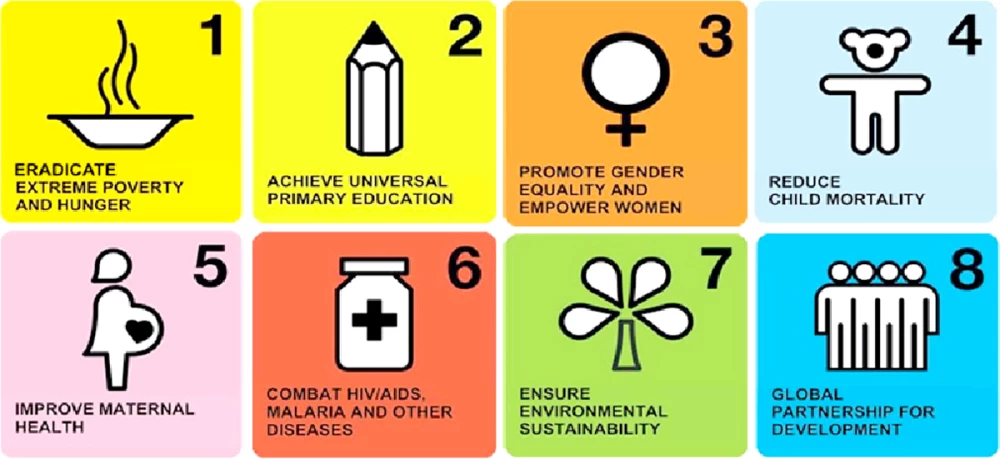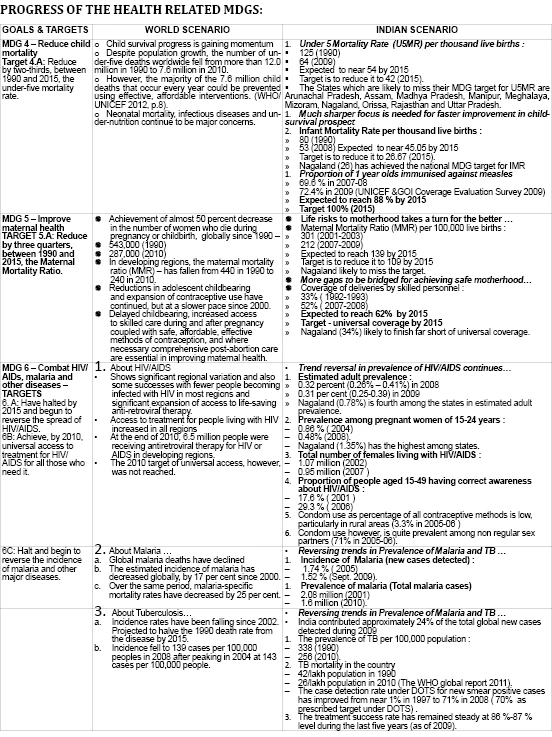
L. Emi Humtsoe
College of Nursing, CIHSR, Dimapur
This slogan was chosen as the theme by the International Nurses’ Association for this year’s International Nurses’ day Celebration. It is intended to be a countdown to 2015, with an emphasis on the health related goals.
BRIEF OVERVIEW OF THE MILLENNIUM DEVELOPMENT GOALS:
The United Nations in 2000 adopted the Millennium declaration (UN 2000) as an affirmation of the commitment to the founding principles of the United Nations, and rededication to a peaceful, equitable and environmentally sustainable world. 189 heads of state in September 2000 adopted the Millennium Declaration during the UN Millennium summit. The plan was for countries and development partners to work together to reduce poverty and hunger, tackle ill-health, gender inequality, lack of education, lack of access to clean water and environmental degradation. From the Millennium Declaration, eight Millennium Development Goals (MDGs) were derived with targets set for 2015, and to be measured in terms of progress since 1990.
THE EIGHT MILLENNIUM DEVELOPMENT GOALS (MDG)
The Eight Millennium Development Goals are interrelated and taken together; they provide a holistic framework for sustainable poverty reduction and development. Three goals – numbers 4, 5 and 6 – are specifically related to health, and their achievement is closely linked to the other goals including those focused on poverty, hunger, gender equality and women’s empowerment.
KEY SUCCESSES OF THE MDGS:
o Reductions in levels of extreme poverty. Estimates indicate that in 2010 the share of the world’s population living on less than $1.25 a day fell to less than half of its 1990 value (1.8 billion). It is projected to be 883 million in 2015, compared with 1.4 billion in 2005 (UN2012a; World Bank 2011).
o Halving the proportion of people without access to drinking water (falling from 24 percent in 1990 to 11 percent in 2010 - UN 2012a).
o Increasing the numbers of girls enrolled in primary schools. Worldwide 97 girls are being enrolled in primary school for every 100 boys (the figure was 91/100 in 1999).
CRITICISMS AND CHALLENGES:
• CRITICISMS:
While there has been undoubted progress, there is still much to be achieved.
o the lack of focus on equity has been one of the main criticisms of the MDGs. Trends of achievement of the goals have been uneven within and across countries and regions, with the poorest and most marginalised continuing to be the most disadvantaged.
o Omission of demographic changes such as the ageing population and the shift from rural to urban dwelling, impacting poverty reduction and health; as well as changes in the disease burden, especially the challenge of non-communicable diseases.
• CHALLENGES TO THE ACHIEVEMENT OF THE MDGS:
o Economic crisis and recession affecting some of the developed world impacting the ability and will of wealthier nations to provide aids to developing countries.

* The Under-Five Mortality Rate (U5MR) is the probability (expressed as a rate per 1000 live births) of a child born in a specified year dying before reaching the age of five if subjected to current age specific mortality rates.
*Infant Mortality Rate (IMR) is defined as the deaths of infants of age less than one year per thousand live births.
*Maternal Mortality Ratio ((MMR) is the number of women who die from any cause related to or aggravated by pregnancy or its management (excluding accidental or incidental causes) during pregnancy and childbirth or within 42 days of termination of pregnancy, irrespective of the duration and site of the pregnancy, per 100,000 live births.
CLOSING THE GAP: NURSING CONTRIBUTION…
Being the largest health care profession in the world, nurses have key roles to play in the country’s achievement of the Millennium Development Goals. Nurses are often the only health professionals accessible to many people in their lifetime and are particularly well placed to reach the underserved and disadvantaged populations. Nurses are educated to understand the complex nature of maintaining health and wellness, and the impact of psychosocial and socio-economic factors such as poverty, unemployment and ethnicity on health. They see the context for wellbeing and accordingly act so as to reach beyond the immediate presenting problems.
Nurses across the world have been actively engaged in local, regional, national and international efforts to tackle the MDGs. Nurses have contributed much towards the achievement of the MDGs and to help shape and deliver sustainable goals and outcomes beyond 2015. While taking pride in their achievements, we also need to understand that there is still more that we can – and must – do.
Being equipped with the right knowledge about the Millennium Development goals and cognisant of the contributions expected of us let us -
• Engage in advocacy and lobbying and thereby influence decision – making by patients, communities, policy makers, governments and others. Participate in planning, forums, conferences and contribute to positive changes.
• Examine how we can strengthen our own structures, systems; improve governance in our establishment; and develop strategies to adhere to standards in our practice and ensure accountability.
• Develop capacity in practice, management and research to enable our profession to thrive in an era where the academic world is much more dynamic and competitive than before. Publish significant research findings to disseminate information.
• Initiate, participate or organize trainings and education sessions for behavioural changes and strengthening right practices.
Be involved in the development of any programme introduced to improve health services and ensure their effective implementation.
• Refuse to compromise with standard of professional practices and lobby for structures and resources to be made available to carry out safe practices.
• Create and take opportunities to work and partner with governments, NGO’s, research and educational institutions and where appropriate the private sectors, donors and funders, and the multidisciplinary health team.
• Continue to support and collaborate with all the nurses, midwives and community health workers who are playing pivotal role in ensuring that India by close of MDG 2015 closes the gap of deficit in the unacceptable level of infant and maternal mortality and HIV infection.
The countdown is on and there is a sense of urgency to make the dreams of yesterday today’s reality and each and every one of us can make a difference. Together we can break through barriers and challenges to deliver the MDGs and meet the health needs of the poorest, most marginalized and underserved communities, wherever we may be posted- even in remote rural areas, where our services are most needed. Let us rise to the challenge of the changing disease burden and the effects of climate change on health, development and environment sustainability and engage in shaping and delivering the new agenda for health and wellbeing of the global community. We are accountable to ourselves, our profession and to God who chose and called us to be nurses.
I conclude with the words of the UN Secretary General Ban Ki-Moon, “There is no global project more worthwhile. We must not fail the billions who look to the International community to fulfil the promise of the Millennium Declaration for a better world. Let us keep the promise.”




